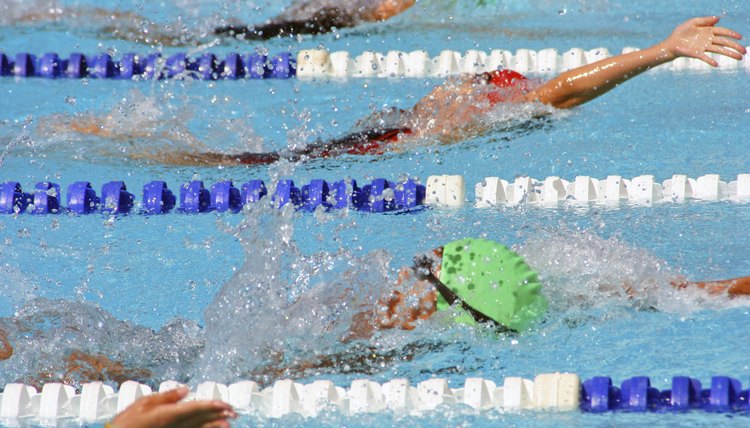Muscles Used in a Flutter Kick

The flutter kick uses alternating leg movements to propel a swimmer through the water. The flutter kick is the kick of choice for swimmers performing the backstroke, which is also called the back crawl, and the freestyle, which is also called the front crawl. Whether you're doing this kick as part of the backstroke or freestyle -- or as a vertical kick while treading water -- you largely work the same muscles.
Muscles Used Swimming
The flutter kick uses all the major muscle groups in the legs. These include your gluteus maximus, quadriceps and hamstrings. Whether on your front or your back, you'll also use your calves as well as three muscles in your feet: the abductor hallucis, abductor digiti minimi and flexor digitorum brevis. Of these muscles, you'll feel the burn the most in your quads, because this muscle on the top of your thighs uses the most energy to push your leg down in the water during the flutter kick.
Muscles Used Treading
When you turn yourself to a vertical position in the water and do the flutter kick while treading water, you change the point of emphasis when it comes to your muscles. While you'll still use the same major muscle groups, it's the glutes -- not the quads -- that feel the burn the most. This is because the quads no longer have to work against gravity to move the legs. Instead, the movement comes more from the energy exertion of the glutes -- the muscles found in your bum. Doing the flutter kick in a vertical position also requires the use of your core, including your abdominal and oblique muscles.
Doing the Flutter Kick
Use a kickboard as you learn to do the flutter kick. Isolating your legs in this way helps you to focus on the movement instead of worrying about what the upper body is doing. Hold on to the top of the kickboard with your hands, resting your arms on the board's flat side. Your legs should be floating on the water's surface, feet pointing in the direction from which you are moving away. Keep your knees straight yet relaxed as you press down into the water with one foot, then the other, allowing each foot to rise back to the surface of the water between kicks.
Flutter Kick Injuries
Because flutter kick is one of the simplest kicks to do in the water, it also carries the lowest risk of injury. However, positioning the feet and ankles in an unnaturally straight position can still cause cramping. This is called plantar flexion and can lead to intense cramps in the calf muscles. To alleviate this pain, stretch your calf muscles or employ gentle massage after a workout. To avoid plantar flexion, stretch your ankles to increase their range of motion before getting into the pool.
References
- The Stretching Institute: Swimming Stretches and Flexibility Exercises
- "Extreme Tri Magazine"; Cramping Your Style: Dealing With Cramps in the Pool; Haydn Wooley; August 2001
Writer Bio
Elizabeth Falwell has been writing for the TV news industry since 2005. Her work has appeared on WXII 12 News, WMGT 41 News, NewParent.com and multiple parenting blogs. A graduate of the S.I. Newhouse School at Syracuse University, Falwell holds a Master of Science in broadcast journalism.
